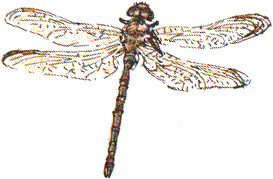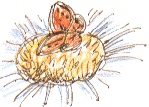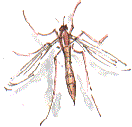
Wings of SummerTuesday 15th August 2000, West Yorkshire A PEACOCK rests, wings outspread against the wall, to face the morning sun, on the house next door. A Brown Hawker dragonfly hunts, like a search helicopter, over the patio, down to the pond and then back over the hedge to next door's garden.  A small orangy butterfly, with a fussy restless flight, flutters over the seedy remnants of the Dog Daisies. It's one of those butterflies that won't settle so that you can compare it with the illustrations in the field guide, but as it's not much bigger than my thumbnail and it hasn't got much in the way of a pattern on its forewings (just a few dark spots and a dark border), I'm sure it must be a Small Copper, a butterfly of 'grassy flowery places, including gardens', to quote my favourite field guide to insects, the Collins Insects of Britain and Western Europe by Michael Chinery.
A small orangy butterfly, with a fussy restless flight, flutters over the seedy remnants of the Dog Daisies. It's one of those butterflies that won't settle so that you can compare it with the illustrations in the field guide, but as it's not much bigger than my thumbnail and it hasn't got much in the way of a pattern on its forewings (just a few dark spots and a dark border), I'm sure it must be a Small Copper, a butterfly of 'grassy flowery places, including gardens', to quote my favourite field guide to insects, the Collins Insects of Britain and Western Europe by Michael Chinery. Despite the sun during the day we don't get a chance to eat out this evening, but at least there's the compensation of a double rainbow over the wood, followed by the rising full moon glimpsed through clouds.
Despite the sun during the day we don't get a chance to eat out this evening, but at least there's the compensation of a double rainbow over the wood, followed by the rising full moon glimpsed through clouds. From indoors I sketch a Crane Fly, often called a 'daddy-long-legs' in Britain, which is resting on the outside of the patio windows. The pointed end to its abdomen shows that this is a female. The point helps when she lays her eggs in the ground. A brown spot on the leading edge of each wing identifies her a Tipula oleracea, one of our commonest species. From indoors I sketch a Crane Fly, often called a 'daddy-long-legs' in Britain, which is resting on the outside of the patio windows. The pointed end to its abdomen shows that this is a female. The point helps when she lays her eggs in the ground. A brown spot on the leading edge of each wing identifies her a Tipula oleracea, one of our commonest species. Good as the Collins guide is for general use, Chinery can't resist passing on an entomologist's tip on how to distinguish this species from a larger relative; Tipula oleracea has 13 segments to its antennae, Tipula paludosa has 14.
Good as the Collins guide is for general use, Chinery can't resist passing on an entomologist's tip on how to distinguish this species from a larger relative; Tipula oleracea has 13 segments to its antennae, Tipula paludosa has 14.Related LinksPhotographs of Tipula oleracea on BioImages: The Virtual Field-Guide (UK).The British Dragonfly Society.
|